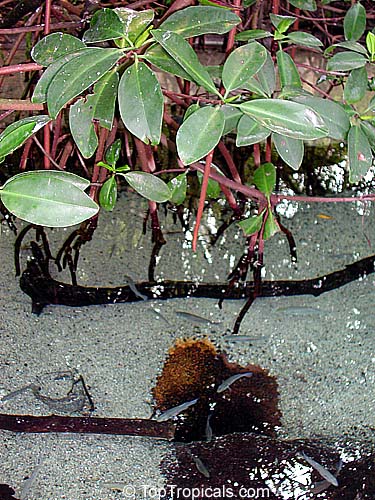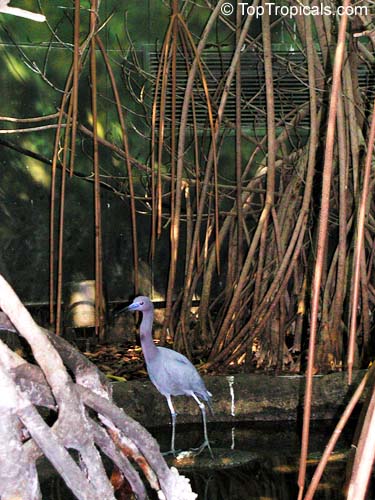Mangroves in aquarium
By .
You may buy mangrove plants here.
If you were lucky enough to visit the beaches of South Florida in October-November, than you were more than likely puzzled by the little husks 15-20 cm in length floating in the ocean. These, are seeds of Red Mangrove trees which can be found throughout the Florida. I have them growing in aquarium with the mudskippers, proving to be a very good filter for the water. Mangroves may be used to filter the organic from fresh water and from salt water fish tanks. If you are bugged with algae, then mangroves are an excellent way to fight them. I have not changed the water in my aquarium with mudskippers for over a year and half, I just add some water over to replace the one that has already evaporated. Nitrates and phosphates are almost at zero.
What are the mangroves
It is said that the word mangrove has originated from the Spanish word mangue (distorted), and English word grove. There is somewhere close to 50 types of these mangrove trees... They are used to growing in salty soil, which is periodically drowned by a tide.

Mangroves are the trees that you will find the most throughout the coastline of South Florida, where they have not been cut down of course. It is illegal now to cut down mangrove trees so you can also find them in in the Florida Keys, which are the continuation of the mainland, you can only find the islands that you can get to by car on a map, but altogether there is about 200 most of which are preserves.
Besides the Red (Rhizophora mangle), you can also find these throughout Florida: black (Avicennia germinans) and white ( Laguncularia racemosa).
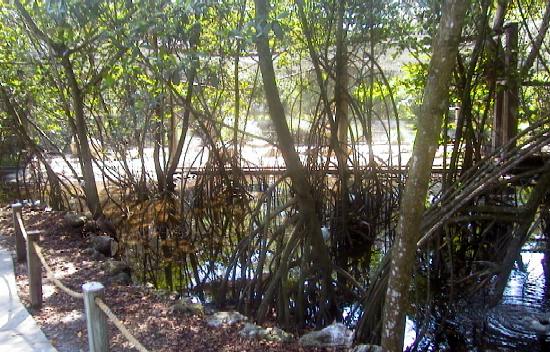
On the picture you can see the grove of the red mangroves.
The water in these parts of the mangrove forest is quite murky, because of tannin, which is emitted when organic material decomposes in the water.
Red mangroves are sometimes called "walking" trees. Because their massive root system is slowly moving towards the water taking up more and more territory as it progresses. The roots grow from the main stock towards the soil through the thickness of the water. The tree is able to set itself on thin "legs", and afterwards create soil, trapping and saving organic sediment (many islands were formed this way).

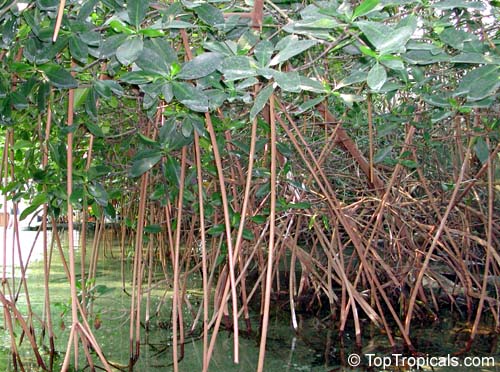
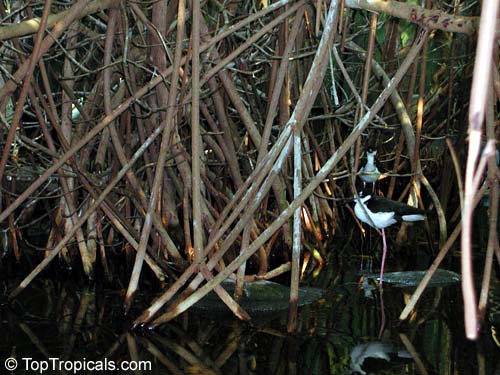
The roots of the tree provide shelter for many organisms such as fish and various invertebrates. One of the most fascinating are mudskippers, which can be seen eating a piece of shrimp on the picture.
These groves can be almost impassible to any animal or man, but to some birds, they make up a great place for a home. A few miles off the coast, towering mangrove groves can be seen, where birds such as pelicans and herons nest.
Where the water washes over the roots of mangroves the water itself is very clean, that is because the roots of the tree absorb the organic material from the water. In these groves you can find many invertebrate which in their turn form a reef.


Red Mangroves trees are viviparous,meaning the seeds mature while they are still on the tree, and only afterwards do they fall in to the water. For the seed to reach its full level of maturity, it needs to spend about a month in the water. During this time, the seed collects the water in its lower portion of the body and floats vertically, with the bud facing skyward, and roots facing down. These seeds will be floating in the salt water for months until they are washed on the shore. One of the conditions needed for the seed to start growing, is absence of disturbances. This is the way nature makes sure that the plant will grow in good conditions. This seed will spend almost a year securing itself in the soil before becoming a young tree.
Red mangroves have the ability to replace sodium ions, which are present in salt water, with magnesium ions. If you have a salt water tank, it is recommended to look after the level of magnesium present in your aquarium, the plants can consume it quite fast. When level of magnesium ions is low, mangrove couldn't replace sodium ions. The plants during that time are in condition of stress, the leaves become yellow and rough. In my aquarium with mudskippers, where the water is somewhere in between salt and fresh (brackish), I regularly add magnesium sulfate (Epsom salt) which can be found in a drug store. If you grow mangroves in freshwater you don't have worry about anything.

On the picture you can see a maturing seedling that still hasn't fallen off the tree.

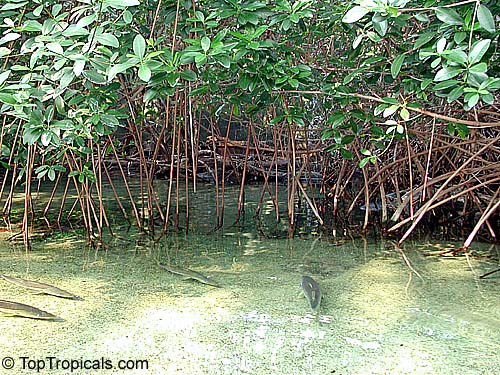
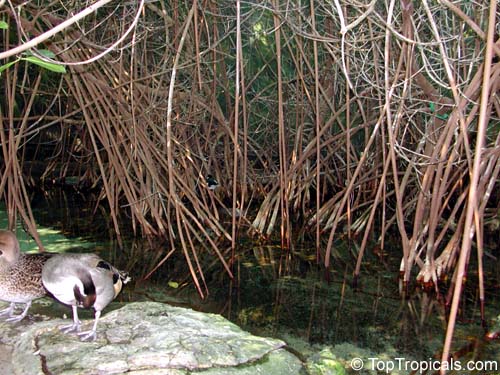
Black mangroves can be distinguished by a system of roots that stick out of the water like pencils, covering the surface in a carpet like formation. These roots contain sponge-like structure and allow gaseous exchange to take place. The seeds of this black mangrove are considerably smaller than that of the red mangrove, which allows the current to carry them further in to the rising-falling tide area of the swamp. Strong currents push the seeds in to thick swamp mud where the seeds shed off their "skin" and cast roots. That is why they are mostly found on high ground, even though I have seen them together with the red mangroves, like on the picture to the left.
The seeds of white mangroves are similar to the black mangroves' and grow on highland areas. White mangroves are unique because they can get rid of salt through their leaves.
Usually aquariums contain red mangroves, that is who most of the information below will be about them. I guess the other species are grown the same way.
Where to find them
Those who live near me, it is very easy, you can collect them yourself and grow them on your own. But first I'd suggest you to familiarize yourself with the laws, for example - in Florida it is illegal to dig mangrove trees out (Mangrove Trimming and Preservation Act, 1996), in Hawaii - no one cares. There is quite a lot of "farms" that grow mangroves and send them in the mail. That is the way I have bought my first mangroves - by mail.
If you want to buy mangroves - check out our online store - Top Tropicals
What to do upon receiving the seeds

You can receive the "seedling" in various forms:
1. Without roots or leaves, only with a bud up at the top (this is the way I had gotten my first mangroves)
2. With roots just beginning to grow, but without leaves
3. With small roots and growing leaves
4. With roots and leaves
It is most likely that you will get yours in the first, or second stage. Nothing to be afraid of, you will only need to spend more effort acclimatizing your seedling, and the results will follow a few months later.
On the picture to the left - I am trying to grow mangroves from seeds on my balcony in a pot. The right plant already has some leaves showing.
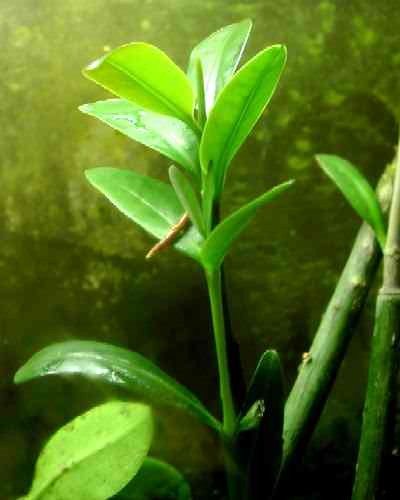
The seeds which you had bought have not seen the light for quite some time, so you should gradually "walk" the plant out of the condition of stress. Please find out to what kind of water was the seed adjusted to (fresh or salt). If your aquarium that the mangrove is going to live in has different water than what the plant is used to, than you must slowly acclimatize it to the water type you have, throughout two weeks
Put the plant in to a moist atmosphere, for example, in to a hothouse, or just enclose the pot in a plastic bag, in which you will gradually make holes, to "teach' the mangrove the atmosphere it will be inhabiting. Usually mangroves prefer high humidity (no less than 60%), and high temperature - about 25 degrees Celsius. In an aquarium you will have somewhat similar habitat. If, however, you are growing them in pots, you will have to worry about the humidity.
Do not cascade the light, fertilizer, etc. do it gradually, and in a few weeks you will notice how from a bud a few little leaves are peaking out.
How to grow a Mangrove
Because Mangroves require a lot of space above the water, it is recommended to plant them in an open aquarium. The space that I have in my aquarium is about 20 cm, which is enough for the plant. Of course you must trim the plant, because one mangrove can easily fill up the whole room.
It is often seen that people grow mangroves in separate aquariums to filter out the water for the main one. In this case plant them before the protein-skimmer, of course only if you use one, so that mangroves can get all the nutrition they will need.
There are various planting methods:
1. In to substrate (the thickness of substrate should be 3-5cm) - this is the way I have it in my aquarium where the level of the water doesn't exceed a couple of centiliters.
2. In to a bag from filter media, where the gravel is poured. The bag afterwards is fastened to the wall of the aquarium or on to a floating piece of foam. This method is easiest for the "trimming" of the roots.
3. Planting the seeds in to pieces of foam - the seeds are planted in a way that the roots are still in the water.
4. Other methods
In any case, to not let the top green part of the plant be submerged underwater. At the age of a year, or a year and a half, the trees let out air roots. But this doesn't always happen. My mangroves do not have them. In this case it is noticed that the root system of the plant is more "massive" and stronger, maybe if the plant doesn't need the air roots, it won't have any. I noticed that my mangroves have massive root system when I had been planting other plants in my aquarium. Keep this in mind when you add "neighbors" to mangroves. I have not seen any information on any other plants coexisting with mangroves, because it is most likely that they are kept in a salt water aquarium, where the choice of vegetation is not that big. But it is more likely that the mangroves can starve it's neighbors.
Mangrove grow quite slowly, which is one of its good abilities, or otherwise they would fill up the whole room pretty quickly. Because the roots of the mangroves are more useful to the aquarium than the leaves, it is recommended to regularly trim it. But if your goal is to grow a giant tree, than you don't have to do that. But they do not seem very appealing to the eye in any way, orchids are much more interesting!
When the plant is fairly small, it shouldn't be bothered. Later on you can pinch off the top leaving a couple of leaves, after that the plant will let off some side branches.
The tree is not very picky when it comes to lighting. I have a compact luminescent lamp above the aquarium with the power of 35W. It is written that a small incandescence lamp close to the plant should be enough. But keep a look out so that the plant won't burn itself on the lamp.
The nutrients that the mangroves need it gets from the water, I sometimes fertilize them with a microelements mixture in the water. Thiel says that the usage of iron accelerates the growth and acclimatization of the plant, but I have not noticed a great difference.
Above it was stated how important that the level of magnesium must be kept under control, if you are growing them in salt water.
All together mangroves are not that hard of a plant to grow.
What are the benefits of growing mangroves
Besides the exotic feeling, they are a great filter for the water, absorb the organic material, phosphates, nitrates etc. from the water.
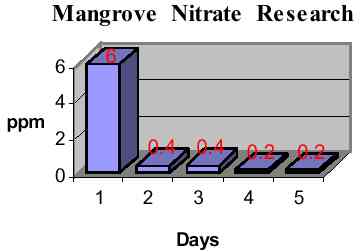
In a salt water tank, with the volume of 55 gal (about 200 liters), 8 mangroves with small roots were added to the habitat. Obviously the nitrates in the duration of the day were "eaten" almost completely.
(William Horst from Eastern PA Reef Club's Newsletter articles )
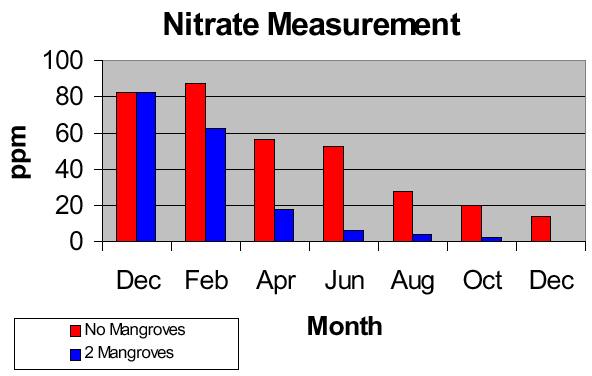

A. Thiel has conducted a special research. Three aquariums with the volume of about 22 gal (about 80 liters) and three aquariums with mangroves. Each aquarium had aproximately 20lb ( somewhere around 10 kg) "live rocks". In each one of those aquariums sat an ordinary yellow tang. Every one of them had the same protein skimmer.
Obviously magroves work very effectively in removing nitrates-phosphates, which are the main cause of the algae problems
I have not conducted any measurements myself. At first, my aquarium with the muddskippers had murky water and everything was covered with long algae (similar to Black Beard algae). Everything had a look of a swamp, which, by the way, didn't disturb the mudskippers. Than, as the mangroves grew, the water started to turn clean, the algae has decreased in numbers. Later on, after the addition of some more mangroves, the water became very clean, and the algi dissapeared, the only thing that was left is the green substance that cover the pieces of wood which are out of the water.
Eventually I have stopped changing water in the aquarium, just adding some to replace the evaporated one. Nitrates and phosphates - almost at zero.
How many mangroves are needed to reach the desired effect? Different authors recommend different numbers - usually one tree per 10-20 liters. Young trees may be used in large numbers. But afterwards when they grow bigger, you should remove some, or otherwise they will not have enough organic material. Or you can provide extra organics in water.
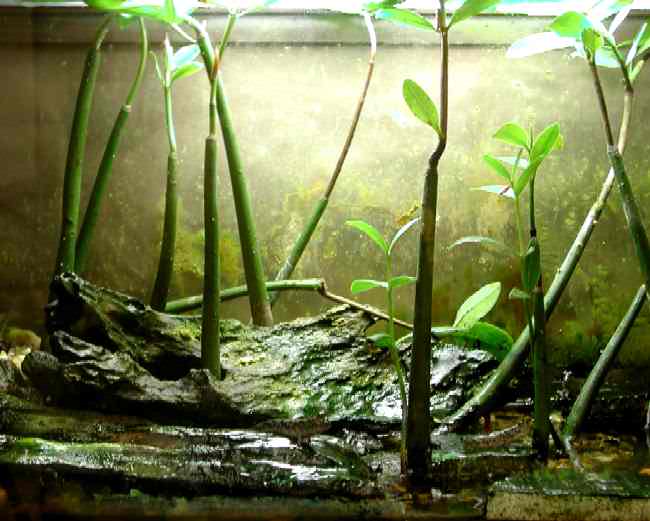
The thing you must always remember when growing mangroves (or anything else related to aquarium) is patience. The results will be only in a couple of months, and they will be.
Make sure to check pictures of our another brakish tank with fiddler crabs.
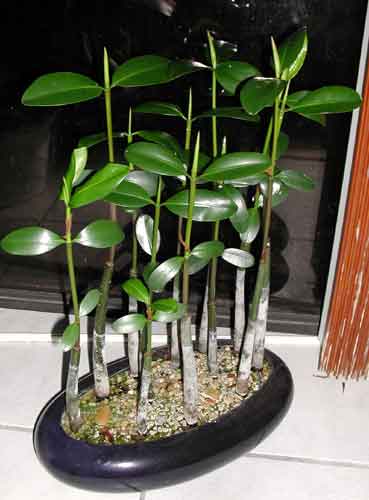
We grow mangrove in our outside pond and even as "lucky mangrove" - stones, water and fertilizer.
You may buy mangrove plants here.
Article by James C. Li
Effects of Ammonium,
Phosphate and Salinity on Growth and Nutrient Content of Seedlings of Mangrove
(Rhizophora mangle)
.pdf file, 392 Kb
